Analyzing Polyethylene Terephthalate Bottle Waste Technology Using an Analytic Hierarchy Process for Developing Countries: A Case Study from Indonesia
Abstract
:1. Introduction
2. Literature Review
3. Methodology
3.1. Goal and Criteria Identification
| Criteria | Sub-Criteria | Reference |
|---|---|---|
| Environment | Air pollution | [26,46] |
| Soil pollution | [46] | |
| Water pollution | [46] | |
| Biodiversity | [47] | |
| Climate change | [47] | |
| Land use | [21] | |
| Resource consumption | Energy consumption | [48] |
| Avoided chemical production | [4] | |
| Economy | Initial investment cost | [20,22] |
| Operation and management cost | [16] | |
| Gate fee | [18] | |
| Society | Public acceptance | [34,44] |
| Job creation | [44] | |
| Public participation | [49] | |
| Human health | [4] | |
| Waste prevention behavior | [44,50] | |
| Policy | Regulation | [18] |
| Administrative incentive | [18] | |
| Public organization | [15,43] | |
| Technical applicability | Maturity | [22] |
| Feasibility | [20] | |
| Capacity | [20] | |
| Product value | [51] |
3.2. Analytical Hierarchy Construction
| Alternatives | Definition | Source |
|---|---|---|
| Open landfill | Final disposal of untreated waste on separate or excavated areas | [52] |
| Sanitary landfill | Final disposal of waste on excavated areas for different types of waste, covered with soil to reduce the negative impacts; possibility of energy generation from exhaust gases | [53] |
| Incineration with energy recovery | Conversion of waste into energy (electricity and heat) | [44] |
| Pelletizing plastic bottle waste | Remelting and extrusion of PET to be used as a raw material | [10] |
| Hydrolysis | Conversion of PET at high temperatures and pressures to produce terephthalic acid and ethylene glycol | [10] |
| Glycolysis | Conversion of PET into ethylene glycol to produce bis(2-hydroxyethyl)terephthalate (BHET) | [10] |
3.3. Pairwise and Stakeholder Opinion
3.4. Data Calculation
3.5. Sensitivity Analysis
4. Analytical Hierarchy Results
4.1. Criteria and Sub-Criteria Comparison
4.2. Expert Evaluation of Alternative Technologies
4.3. Comparison of Alternative Technologies
4.4. Sensitivity Analysis
5. Discussion
5.1. Criteria and Sub-Criteria Implications
5.2. Technology Implementation Scenario
6. Conclusions
Supplementary Materials
Author Contributions
Funding
Data Availability Statement
Acknowledgments
Conflicts of Interest
References
- Nisticò, R. Polyethylene Terephthalate (PET) in the Packaging Industry. Polym. Test. 2020, 90, 106707. [Google Scholar] [CrossRef]
- Benavides, P.T.; Dunn, J.B.; Han, J.; Biddy, M.; Markham, J. Exploring Comparative Energy and Environmental Benefits of Virgin, Recycled, and Bio-Derived PET Bottles. ACS Sustain. Chem. Eng. 2018, 6, 9725–9733. [Google Scholar] [CrossRef]
- Zhang, R.; Ma, X.; Shen, X.; Zhai, Y.; Zhang, T.; Ji, C.; Hong, J. PET Bottles Recycling in China: An LCA Coupled with LCC Case Study of Blanket Production Made of Waste PET Bottles. J. Environ. Manag. 2020, 260, 110062. [Google Scholar] [CrossRef] [PubMed]
- Martin, E.J.P.; Oliveira, D.S.B.L.; Oliveira, L.S.B.L.; Bezerra, B.S. Life Cycle Comparative Assessment of Pet Bottle Waste Management Options: A Case Study for the City of Bauru, Brazil. Waste Manag. 2021, 119, 226–234. [Google Scholar] [CrossRef] [PubMed]
- Webb, H.; Arnott, J.; Crawford, R.; Ivanova, E. Plastic Degradation and Its Environmental Implications with Special Reference to Poly (Ethylene Terephthalate). Polymers 2012, 5, 1–18. [Google Scholar] [CrossRef]
- Andriani, D.; Atmaja, T.D. The Potentials of Landfill Gas Production: A Review on Municipal Solid Waste Management in Indonesia. J. Mater. Cycles Waste Manag. 2019, 21, 1572–1586. [Google Scholar] [CrossRef]
- Jambeck, J.R.; Geyer, R.; Wilcox, C.; Siegler, T.R.; Perryman, M.; Andrady, A.; Narayan, R.; Law, K.L. Plastic Waste Inputs from Land into the Ocean. Sciencemag 2015, 347, 768. [Google Scholar] [CrossRef]
- Jariyah, N.I.; Andarisa, A.D.; Dwi, R.A. Level of Student Awareness in Using Tumbler Water Bottles in an Effort to Reduce the Use of Plastic Bottles. Int. J. Innov. 2020, 10, 13. [Google Scholar]
- Balwada, J.; Samaiya, S.; Mishra, R.P. Packaging Plastic Waste Management for a Circular Economy and Identifying a Better Waste Collection System Using Analytical Hierarchy Process (AHP). Procedia CIRP 2021, 98, 270–275. [Google Scholar] [CrossRef]
- Ragaert, K.; Delva, L.; Van Geem, K. Mechanical and Chemical Recycling of Solid Plastic Waste. Waste Manag. 2017, 69, 24–58. [Google Scholar] [CrossRef] [PubMed]
- Fidelis, R.; Ferreira, M.A.; Colmenero, J.C. Selecting a Location to Install a Plastic Processing Center: Network of Recycling Cooperatives. Resour. Conserv. Recycl. 2015, 103, 1–8. [Google Scholar] [CrossRef]
- Gu, Y.; Zhou, G.; Wu, Y.; Xu, M.; Chang, T.; Gong, Y.; Zuo, T. Environmental Performance Analysis on Resource Multiple-Life-Cycle Recycling System: Evidence from Waste Pet Bottles in China. Resour. Conserv. Recycl. 2020, 158, 104821. [Google Scholar] [CrossRef]
- Achillas, C.; Moussiopoulos, N.; Karagiannidis, A.; Banias, G.; Perkoulidis, G. The Use of Multi-Criteria Decision Analysis to Tackle Waste Management Problems: A Literature Review. Waste Manag. Res. 2013, 31, 115–129. [Google Scholar] [CrossRef]
- Soltani, A.; Sadiq, R.; Hewage, K. Selecting Sustainable Waste-to-Energy Technologies for Municipal Solid Waste Treatment: A Game Theory Approach for Group Decision-Making. J. Clean. Prod. 2016, 113, 388–399. [Google Scholar] [CrossRef]
- Gutiérrez Galicia, F.; Coria Páez, A.L.; Tejeida Padilla, R. A Study and Factor Identification of Municipal Solid Waste Management in Mexico City. Sustainability 2019, 11, 6305. [Google Scholar] [CrossRef]
- Kurbatova, A.; Abu-Qdais, H.A. Using Multi-Criteria Decision Analysis to Select Waste to Energy Technology for a Mega City: The Case of Moscow. Sustainability 2020, 12, 9828. [Google Scholar] [CrossRef]
- Taboada-González, P.; Aguilar-Virgen, Q.; Ojeda-Benítez, S.; Cruz-Sotelo, S. Application of Analytic Hierarchy Process in a Waste Treatment Technology Assessment in Mexico. Environ. Monit. Assess. 2014, 186, 5777–5795. [Google Scholar] [CrossRef]
- Yap, H.Y.; Nixon, J.D. A Multi-Criteria Analysis of Options for Energy Recovery from Municipal Solid Waste in India and the UK. Waste Manag. 2015, 46, 265–277. [Google Scholar] [CrossRef]
- Asefi, H.; Lim, S. A Novel Multi-Dimensional Modeling Approach to Integrated Municipal Solid Waste Management. J. Clean. Prod. 2017, 166, 1131–1143. [Google Scholar] [CrossRef]
- Arıkan, E.; Şimşit-Kalender, Z.T.; Vayvay, Ö. Solid Waste Disposal Methodology Selection Using Multi-Criteria Decision Making Methods and an Application in Turkey. J. Clean. Prod. 2017, 142, 403–412. [Google Scholar] [CrossRef]
- Liu, B.; Tang, J.; Li, Z.; Yan, Y.; Chen, J. Optimal Selection of Sewage Treatment Technologies in Town Areas: A Coupled Multi-Criteria Decision-Making Model. Environ. Manag. 2020, 66, 709–721. [Google Scholar] [CrossRef] [PubMed]
- Alao, M.A.; Ayodele, T.R.; Ogunjuyigbe, A.S.O.; Popoola, O.M. Multi-Criteria Decision Based Waste to Energy Technology Selection Using Entropy-Weighted TOPSIS Technique: The Case Study of Lagos, Nigeria. Energy 2020, 201, 117675. [Google Scholar] [CrossRef]
- Sudibyo, H.; Majid, A.I.; Pradana, Y.S.; Budhijanto, W.; Deendarlianto; Budiman, A. Technological Evaluation of Municipal Solid Waste Management System in Indonesia. Energy Procedia 2017, 105, 263–269. [Google Scholar] [CrossRef]
- Babalola, M.A. A Multi-Criteria Decision Analysis of Waste Treatment Options for Food and Biodegradable Waste Management in Japan. Environments 2015, 2, 471–488. [Google Scholar] [CrossRef]
- Greene, K.L.; Tonjes, D.J. Quantitative Assessments of Municipal Waste Management Systems: Using Different Indicators to Compare and Rank Programs in New York State. Waste Manag. 2014, 34, 825–836. [Google Scholar] [CrossRef] [PubMed]
- Govind Kharat, M.; Murthy, S.; Jaisingh Kamble, S.; Raut, R.D.; Kamble, S.S.; Govind Kharat, M. Fuzzy Multi-Criteria Decision Analysis for Environmentally Conscious Solid Waste Treatment and Disposal Technology Selection. Technol. Soc. 2019, 57, 20–29. [Google Scholar] [CrossRef]
- Shahnazari, A.; Rafiee, M.; Rohani, A.; Bhushan Nagar, B.; Ebrahiminik, M.A.; Aghkhani, M.H. Identification of Effective Factors to Select Energy Recovery Technologies from Municipal Solid Waste Using Multi-Criteria Decision Making (MCDM): A Review of Thermochemical Technologies. Sustain. Energy Technol. Assess. 2020, 40, 100737. [Google Scholar] [CrossRef]
- Khoshand, A.; Rahimi, K.; Ehteshami, M.; Gharaei, S. Fuzzy AHP Approach for Prioritizing Electronic Waste Management Options: A Case Study of Tehran, Iran. Environ. Sci. Pollut. Res. 2019, 26, 9649–9660. [Google Scholar] [CrossRef]
- Etim, M.-A.; Academe, S.; Emenike, P.; Omole, D. Application of Multi-Criteria Decision Approach in the Assessment of Medical Waste Management Systems in Nigeria. Sustainability 2021, 13, 10914. [Google Scholar] [CrossRef]
- Bałazińska, M.; Kruczek, M.; Bondaruk, J. The Environmental Impact of Various Forms of Waste PET Bottle Management. Int. J. Sustain. Dev. World Ecol. 2021, 28, 473–480. [Google Scholar] [CrossRef]
- Damayanti; Wu, H.-S. Strategic Possibility Routes of Recycled PET. Polymers 2021, 13, 1475. [Google Scholar] [CrossRef] [PubMed]
- Foolmaun, R.K.; Ramjeawon, T. Life Cycle Sustainability Assessments (LCSA) of Four Disposal Scenarios for Used Polyethylene Terephthalate (PET) Bottles in Mauritius. Environ. Dev. Sustain. 2013, 15, 783–806. [Google Scholar] [CrossRef]
- Neo, E.R.K.; Soo, G.C.Y.; Tan, D.Z.L.; Cady, K.; Tong, K.T.; Low, J.S.C. Life Cycle Assessment of Plastic Waste End-of-Life for India and Indonesia. Resour. Conserv. Recycl. 2021, 174, 105774. [Google Scholar] [CrossRef]
- Qazi, W.A.; Abushammala, M.F.; Azam, M.-H. Multi-Criteria Decision Analysis of Waste-to-Energy Technologies for Municipal Solid Waste Management in Sultanate of Oman. Waste Manag. Res. 2018, 36, 594–605. [Google Scholar] [CrossRef]
- Voudrias, E.A. Technology Selection for Infectious Medical Waste Treatment Using the Analytic Hierarchy Process. J. Air Waste Manag. Assoc. 2016, 66, 663–672. [Google Scholar] [CrossRef]
- Azahari, S.N.S.S.; Abas, M.A.; Hussin, H.; Nor, A.N.M.; Wee, S.T.; Fitriani, N.; Yusoof, M.R.M. Developing a Sustainable Solid Waste Management System Using Analytical Hierarchy Process (AHP) Method at Pondok Institutions in Kelantan. IOP Conf. Ser. Earth Environ. Sci. 2021, 842, 012060. [Google Scholar] [CrossRef]
- Delvere, I.; Iltina, M.; Shanbayev, M.; Abildayeva, A.; Kuzhamberdieva, S.; Blumberga, D. Evaluation of Polymer Matrix Composite Waste Recycling Methods. Environ. Clim. Technol. 2019, 23, 168–187. [Google Scholar] [CrossRef]
- Saaty, T.L.; Vargas, L.G. Models, Methods, Concepts & Applications of the Analytic Hierarchy Process; International Series in Operations Research & Management Science: Boston, MA, USA, 2012; Volume 175, ISBN 978-1-4614-3596-9. [Google Scholar]
- Xu, C.; Tang, T.; Jia, H.; Xu, M.; Xu, T.; Liu, Z.; Long, Y.; Zhang, R. Benefits of Coupled Green and Grey Infrastructure Systems: Evidence Based on Analytic Hierarchy Process and Life Cycle Costing. Resour. Conserv. Recycl. 2019, 151, 104478. [Google Scholar] [CrossRef]
- Cao, W.; Wang, A.; Yu, D.; Liu, S.; Hou, W. Establishment and Implementation of an Asphalt Pavement Recycling Decision System Based on the Analytic Hierarchy Process. Resour. Conserv. Recycl. 2019, 149, 738–749. [Google Scholar] [CrossRef]
- Gebrezgabher, S.; Taron, A.; Amewu, S. Investment Climate Indicators for Waste Reuse Enterprises in Developing Countries: Application of Analytical Hierarchy Process and Goal Programming Model. Resour. Conserv. Recycl. 2019, 144, 223–232. [Google Scholar] [CrossRef]
- Nie, Y.; Wu, Y.; Zhao, J.; Zhao, J.; Chen, X.; Maraseni, T.; Qian, G. Is the Finer the Better for Municipal Solid Waste (MSW) Classification in View of Recyclable Constituents? A Comprehensive Social, Economic and Environmental Analysis. Waste Manag. 2018, 79, 472–480. [Google Scholar] [CrossRef] [PubMed]
- Tseng, M.-L.; Chang, C.-H.; Lin, C.-W.; Nguyen, T.T.H.; Lim, M.K. Environmental Responsibility Drives Board Structure and Financial and Governance Performance: A Cause and Effect Model with Qualitative Information. J. Clean. Prod. 2020, 258, 120668. [Google Scholar] [CrossRef]
- Wu, Y.; Tao, Y.; Deng, Z.; Zhou, J.; Xu, C.; Zhang, B. A Fuzzy Analysis Framework for Waste Incineration Power Plant Comprehensive Benefit Evaluation from Refuse Classification Perspective. J. Clean. Prod. 2020, 258, 120734. [Google Scholar] [CrossRef]
- Zhang, L.; Lavagnolo, M.C.; Bai, H.; Pivato, A.; Raga, R.; Yue, D. Environmental and Economic Assessment of Leachate Concentrate Treatment Technologies Using Analytic Hierarchy Process. Resour. Conserv. Recycl. 2019, 141, 474–480. [Google Scholar] [CrossRef]
- Khoshand, A.; Khanlari, K.; Abbasianjahromi, H.; Zoghi, M. Construction and Demolition Waste Management: Fuzzy Analytic Hierarchy Process Approach. Waste Manag. Res. 2020, 38, 773–782. [Google Scholar] [CrossRef] [PubMed]
- Kharat, M.G.; Kamble, S.J.; Raut, R.D.; Kamble, S.S.; Dhume, S.M. Modeling Landfill Site Selection Using an Integrated Fuzzy MCDM Approach. Model. Earth Syst. Environ. 2016, 2, 53. [Google Scholar] [CrossRef]
- Das, S.; Lee, S.-H.; Kumar, P.; Kim, K.-H.; Lee, S.S.; Bhattacharya, S.S. Solid Waste Management: Scope and the Challenge of Sustainability. J. Clean. Prod. 2019, 228, 658–678. [Google Scholar] [CrossRef]
- Khan, S.; Farooqi, I.H. Prioritising Municipal Solid Waste Management Factors in India Using Fuzzy Analytic Hierarchy Process. IJEWM 2012, 10, 423. [Google Scholar] [CrossRef]
- Corsini, F.; Gusmerotti, N.M.; Testa, F.; Iraldo, F. Exploring Waste Prevention Behaviour through Empirical Research. Waste Manag. 2018, 79, 132–141. [Google Scholar] [CrossRef]
- Połomka, J.; Jędrczak, A.; Myszograj, S. Risk and Opportunity of Using Plastics from Waste Collected in a Yellow Bag. Polymers 2020, 12, 1815. [Google Scholar] [CrossRef]
- Vaverková, M.D. Landfill Impacts on the Environment—Review. Geosciences 2019, 9, 431. [Google Scholar] [CrossRef]
- Sharma, K.D.; Jain, S. Municipal Solid Waste Generation, Composition, and Management: The Global Scenario. SRJ 2020, 16, 917–948. [Google Scholar] [CrossRef]
- Saaty, T.L. How to Make a Decision: The Analytic Hierarchy Process. Eur. J. Oper. Res. 1990, 48, 18. [Google Scholar] [CrossRef]
- Qdais, H.A.; Alshraideh, H. Selection of Management Option for Solid Waste from Olive Oil Industry Using the Analytical Hierarchy Process. J. Mater. Cycles Waste Manag. 2016, 18, 177–185. [Google Scholar] [CrossRef]
- Amheka, A.; Higano, Y.; Mizunoya, T.; Yabar, H. An Overview of Current Household Waste Management in Indonesia: Development of a New Integrated Strategy. Int. J. Environ. Waste Manag. 2015, 15, 86. [Google Scholar] [CrossRef]
- Damanhuri, E.; Handoko, W.; Padmi, T. Municipal Solid Waste Management in Indonesia. In Municipal Solid Waste Management in Asia and the Pacific Islands; Pariatamby, A., Tanaka, M., Eds.; Environmental Science and Engineering Springer: Singapore, 2014; pp. 139–155. ISBN 978-981-4451-72-7. [Google Scholar]
- Takahashi, W. Economic Rationalism or Administrative Rationalism? Curbside Collection Systems in Sweden and Japan. J. Clean. Prod. 2020, 242, 118288. [Google Scholar] [CrossRef]
- Phillipp, R.; Burdett, R. Cities: Investing in Energy and Resource Efficiency. In Towards a Green Economy: Pathways to Sustainable Development and Poverty Eradication—A Synthesis for Policy Makers; United Nations Environment Programme: St-Martin-Bellevue, France, 2011. [Google Scholar]
- Nurbaiti, A. The Apps Helping Indonesia’s Waste Collectors 2021. Available online: https://www.newsecuritybeat.org/2021/09/apps-helping-indonesias-waste-collectors/ (accessed on 12 August 2021).
- Beiler, B.C.; de Arruda Ignácio, P.S.; Pacagnella Júnior, A.C.; Anholon, R.; Rampasso, I.S. Reverse Logistics System Analysis of a Brazilian Beverage Company: An Exploratory Study. J. Clean. Prod. 2020, 274, 122624. [Google Scholar] [CrossRef]
- Kristanto, G.A.; Kemala, D.; Nandhita, P.A. Challenges Confronting Waste Pickers in Indonesia: An on-Field Analysis. Waste Manag. Res. 2021, 0734242X211029181. [Google Scholar] [CrossRef]
- Jayaweera, M.; Perera, H.; Bandara, N.; Danushika, G.; Gunawardana, B.; Somaratne, C.; Manatunge, J.; Zoysa, K.; Thathsara, T. Migration of Phthalates from PET Water Bottle in Events of Repeated Uses and Associated Risk Assessment. Environ. Sci. Pollut. Res. 2020, 27, 39149–39163. [Google Scholar] [CrossRef]
- Dwianika, A.; Murwaningsari, E.; Suparta, W. Analysis of Water Awareness, Accountability, and Governance to Improve Sustainability of Firm’s Performance in Urban Areas. GT 2020, 15, 35–42. [Google Scholar] [CrossRef]
- Takama, T.; Aldrian, E.; Kusumaningtyas, S.D.A.; Sulistya, W. Identified Vulnerability Contexts for a Paddy Production Assessment with Climate Change in Bali, Indonesia. Clim. Dev. 2017, 9, 110–123. [Google Scholar] [CrossRef]
- Raheem, A.B.; Noor, Z.Z.; Hassan, A.; Abd Hamid, M.K.; Samsudin, S.A.; Sabeen, A.H. Current Developments in Chemical Recycling of Post-Consumer Polyethylene Terephthalate Wastes for New Materials Production: A Review. J. Clean. Prod. 2019, 225, 1052–1064. [Google Scholar] [CrossRef]
- Environment and Forestry Ministry of Indonesia National Plastic Waste Reduction Strategic Actions for Indonesia 2020. Available online: https://www.unep.org/ietc/resources/policy-and-strategy/national-plastic-waste-reduction-strategic-actions-indonesia (accessed on 12 August 2021).
- Wang, Y.; Xu, L.; Solangi, Y.A. Strategic Renewable Energy Resources Selection for Pakistan: Based on SWOT-Fuzzy AHP Approach. Sustain. Cities Soc. 2020, 52, 101861. [Google Scholar] [CrossRef]
- Sekito, T.; Prayogo, T.B.; Meidiana, C.; Shimamoto, H.; Dote, Y. Estimating the Flow of Recyclable Items and Potential Revenue at a Waste Bank: The Case in Malang City, Indonesia. Environ. Dev. Sustain. 2019, 21, 2979–2995. [Google Scholar] [CrossRef]
- Sondang Siagian, E.; Sumaryana, A.; Widianingsih, I.; Nurasa, H. Public-Private Partnerships in Solid Waste Management in Indonesia: The Need for Technical Regulation. Asia Pac. J. Public Adm. 2019, 41, 246–250. [Google Scholar] [CrossRef]
- Liang, Y.; Tan, Q.; Song, Q.; Li, J. An Analysis of the Plastic Waste Trade and Management in Asia. Waste Manag. 2021, 119, 242–253. [Google Scholar] [CrossRef] [PubMed]
- Putri, A.R.; Fujimori, T.; Takaoka, M. Plastic Waste Management in Jakarta, Indonesia: Evaluation of Material Flow and Recycling Scheme. J. Mater. Cycles Waste Manag. 2018, 20, 2140–2149. [Google Scholar] [CrossRef]
- Qonitan, F.D.; Wayan Koko Suryawan, I.; Rahman, A. Overview of Municipal Solid Waste Generation and Energy Utilization Potential in Major Cities of Indonesia. J. Phys. Conf. Ser. 2021, 1858, 012064. [Google Scholar] [CrossRef]
- Kristanto, G.A.; Koven, W. Estimating Greenhouse Gas Emissions from Municipal Solid Waste Management in Depok, Indonesia. City Environ. Interact. 2019, 4, 100027. [Google Scholar] [CrossRef]
- Lokahita, B.; Samudro, G.; Huboyo, H.S.; Aziz, M.; Takahashi, F. Energy Recovery Potential from Excavating Municipal Solid Waste Dumpsite in Indonesia. Energy Procedia 2019, 158, 243–248. [Google Scholar] [CrossRef]
- Brotosusilo, A.; Handayani, D. Dataset on Waste Management Behaviors of Urban Citizens in Large Cities of Indonesia. Data Brief 2020, 32, 106053. [Google Scholar] [CrossRef]
- Sasaki, S.; Watanabe, K.; Lee, K.; Widyaningsih, N.; Baek, Y.; Araki, T. Recycling Contributions of Dumpsite Waste Pickers in Bantar Gebang, Indonesia. J. Mater. Cycles Waste Manag. 2020, 22, 1662–1671. [Google Scholar] [CrossRef]
- Sandu, C.; Takacs, E.; Suaria, G.; Borgogno, F.; Laforsch, C.; Löder, M.M.G.J.; Tweehuysen, G.; Florea, L. Society Role in the Reduction of Plastic Pollution. In Plastics in the Aquatic Environment–Part II; Stock, F., Reifferscheid, G., Brennholt, N., Kostianaia, E., Eds.; The Handbook of Environmental Chemistry; Springer International Publishing: Cham, Germany, 2020; Volume 112, pp. 39–65. ISBN 978-3-030-84113-3. [Google Scholar]
- Farahbakhsh, A.; Forghani, M.A. Sustainable Location and Route Planning with GIS for Waste Sorting Centers, Case Study: Kerman, Iran. Waste Manag. Res. 2019, 37, 287–300. [Google Scholar] [CrossRef] [PubMed]
- Vučijak, B.; Kurtagić, S.M.; Silajdžić, I. Multicriteria Decision Making in Selecting Best Solid Waste Management Scenario: A Municipal Case Study from Bosnia and Herzegovina. J. Clean. Prod. 2016, 130, 166–174. [Google Scholar] [CrossRef]
- Ma, B.; Li, X.; Jiang, Z.; Jiang, J. Recycle More, Waste More? When Recycling Efforts Increase Resource Consumption. J. Clean. Prod. 2019, 206, 870–877. [Google Scholar] [CrossRef]
- Moosavi, M.; Ghorbannezhad, P.; Azizi, M.; Zarea Hosseinabadi, H. Evaluation of Life Cycle Assessment in a Paper Manufacture by Analytical Hierarchy Process. Int. J. Sustain. Eng. 2021, 14, 1647–1657. [Google Scholar] [CrossRef]
- Ministry of Environment and Forest Sistem Informasi Manajemen Bank Sampah. Available online: https://simba.id/ (accessed on 12 August 2021).
- Aleluia, J.; Ferrão, P. Assessing the Costs of Municipal Solid Waste Treatment Technologies in Developing Asian Countries. Waste Manag. 2017, 69, 592–608. [Google Scholar] [CrossRef] [PubMed]
- Kanchanapiya, P.; Intaranon, N.; Tantisattayakul, T. Assessment of the Economic Recycling Potential of a Glycolysis Treatment of Rigid Polyurethane Foam Waste: A Case Study from Thailand. J. Environ. Manag. 2021, 280, 111638. [Google Scholar] [CrossRef] [PubMed]
- Suhaimi, N.A.S.; Muhamad, F.; Abd Razak, N.A.; Zeimaran, E. Recycling of Polyethylene Terephthalate Wastes: A Review of Technologies, Routes, and Applications. Polym. Eng. Sci. 2022, 62, 2355–2375. [Google Scholar] [CrossRef]
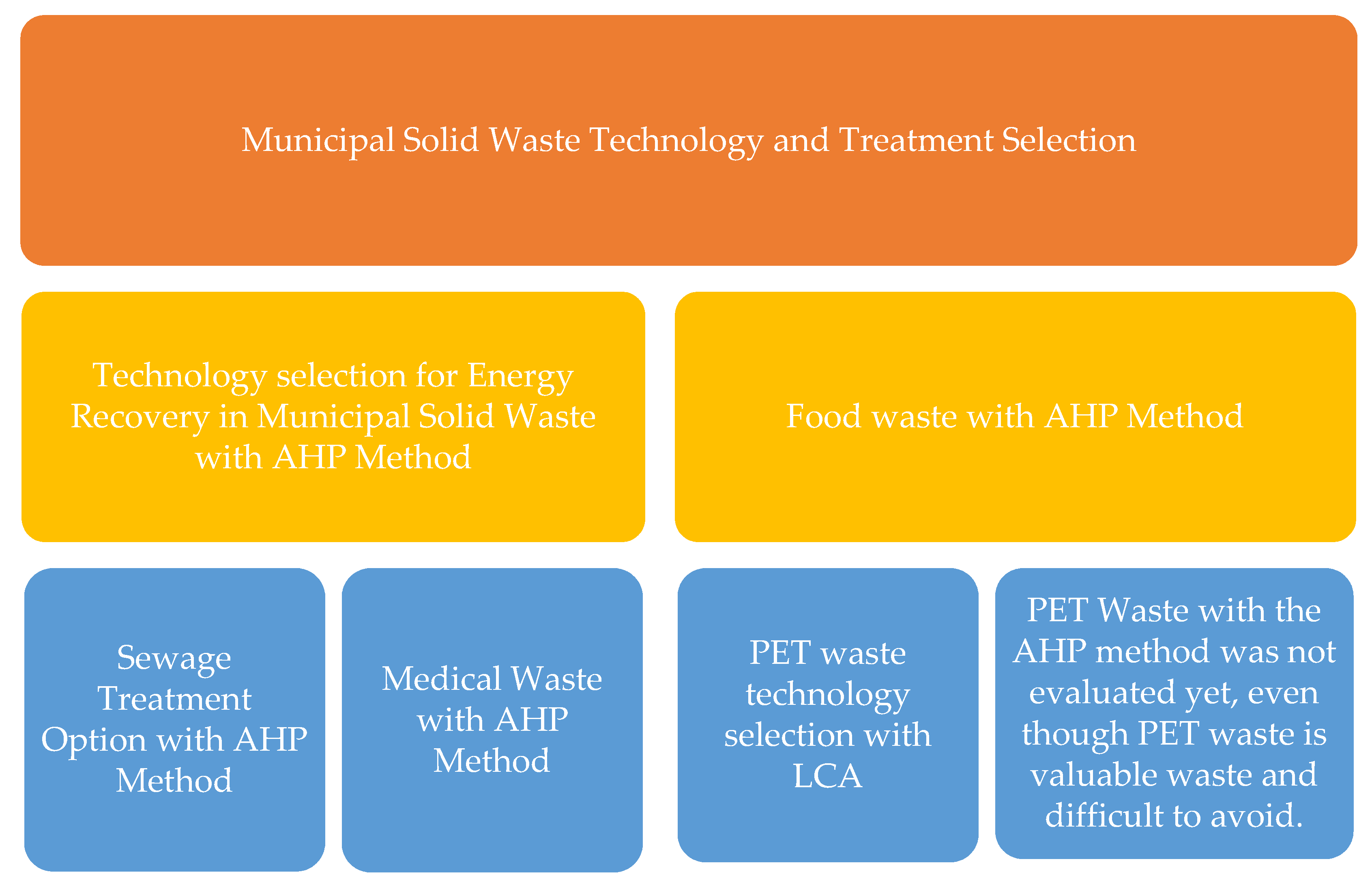


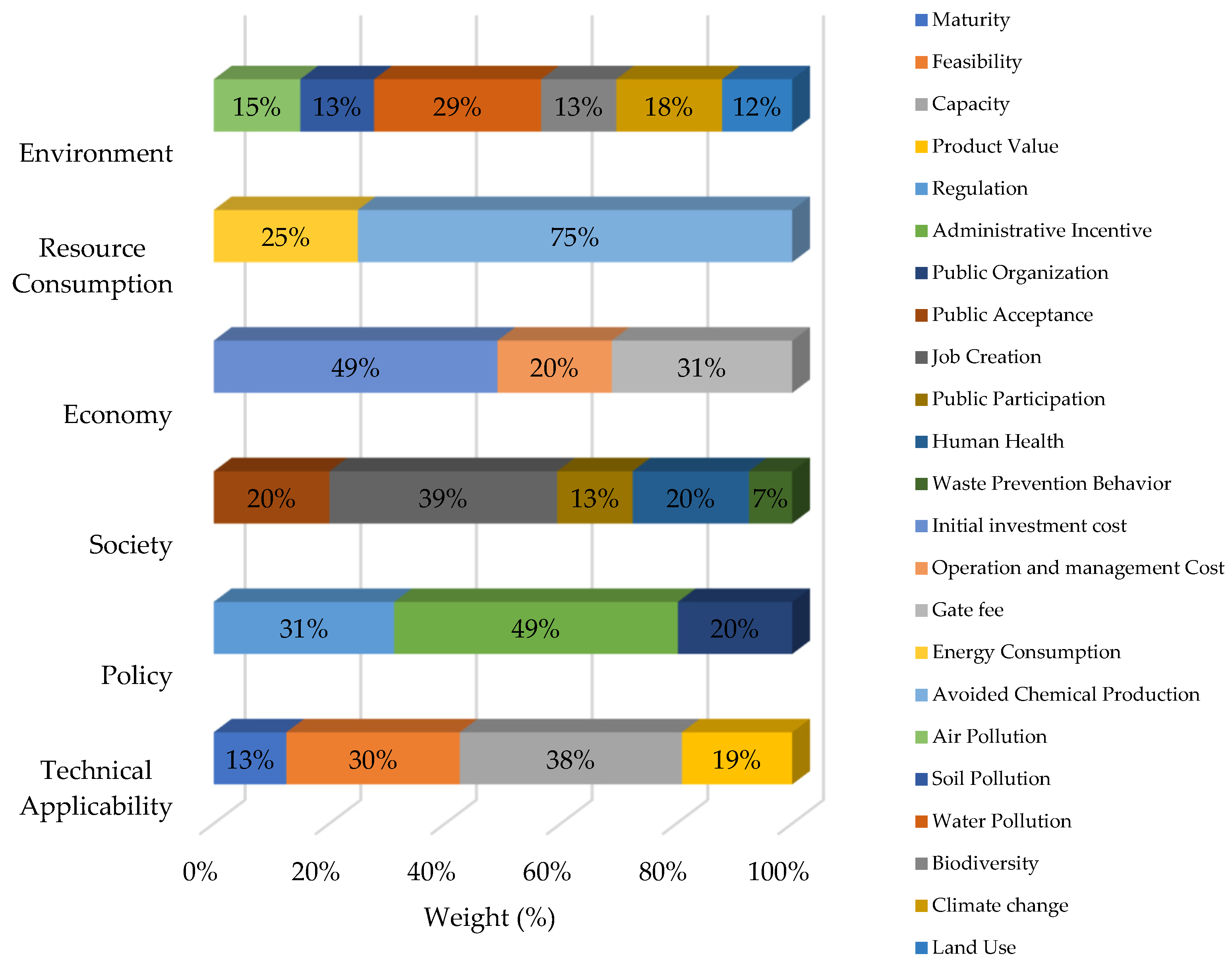
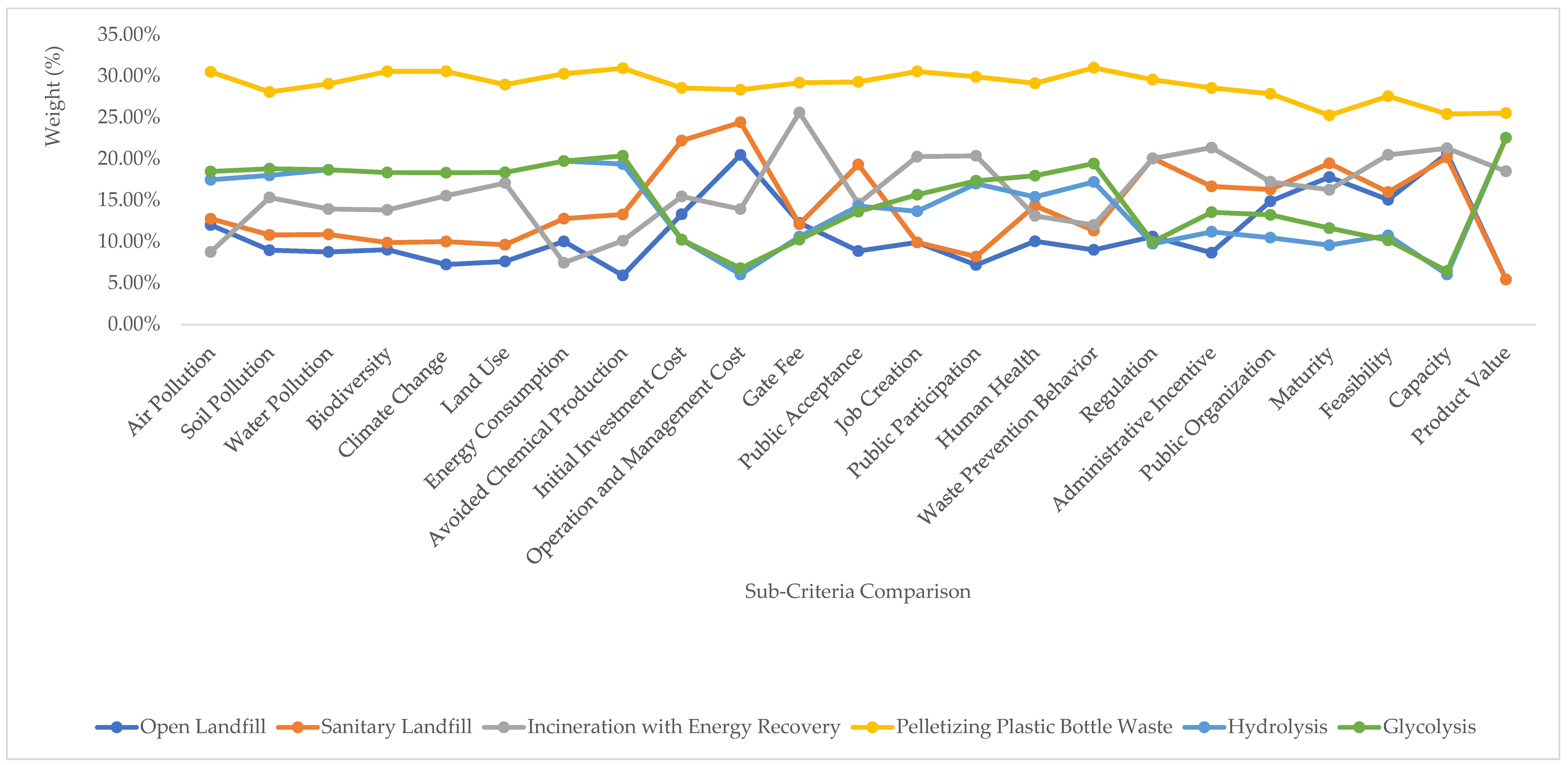
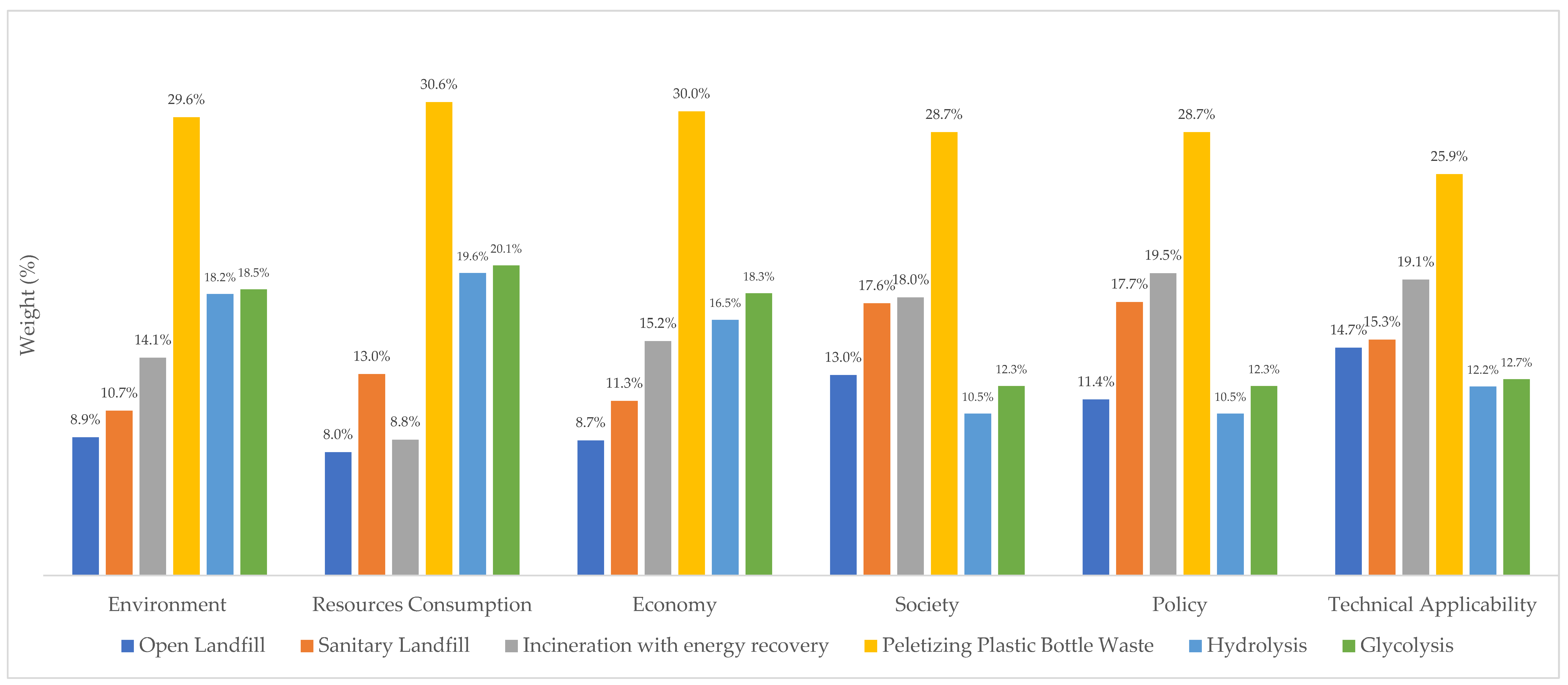

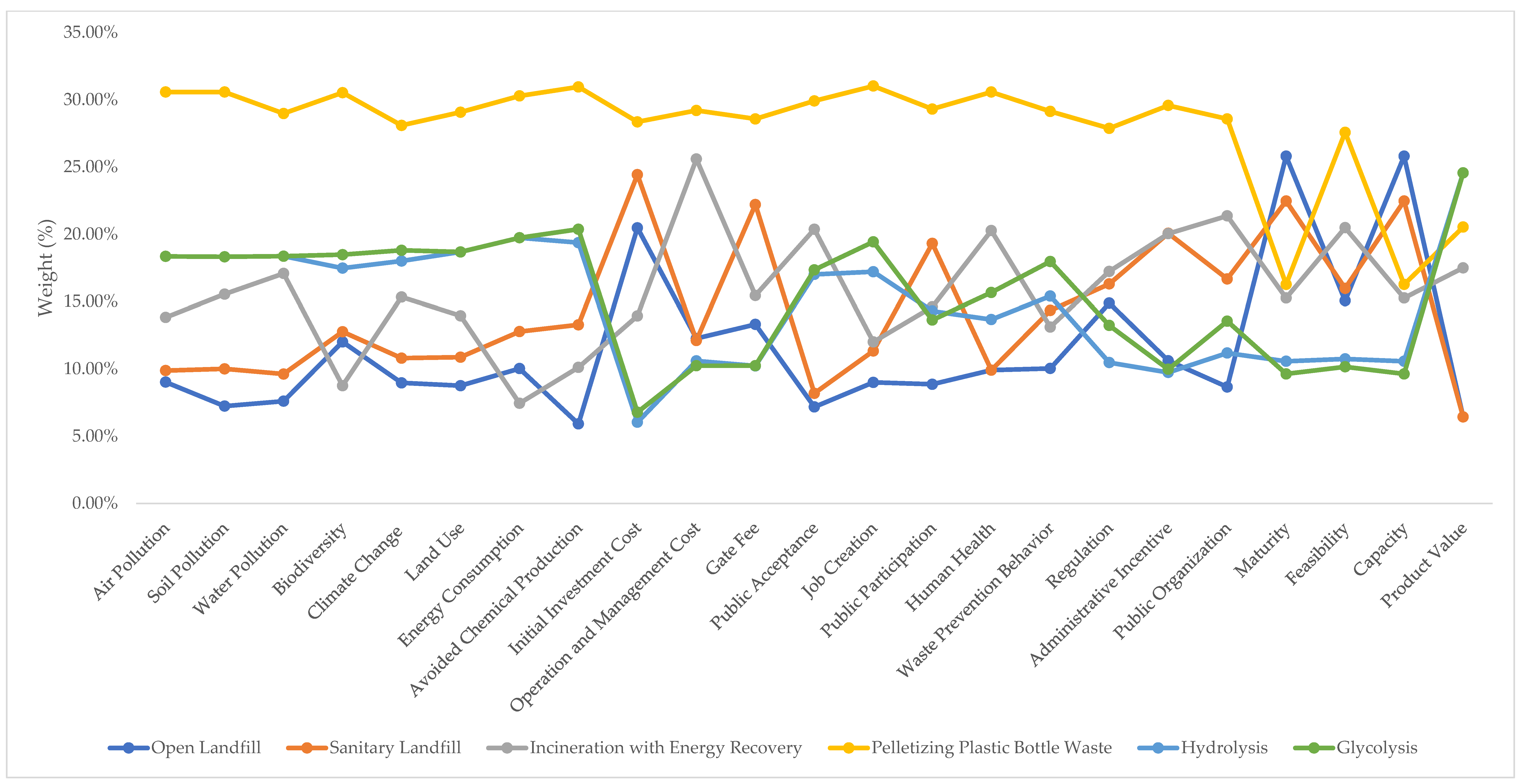
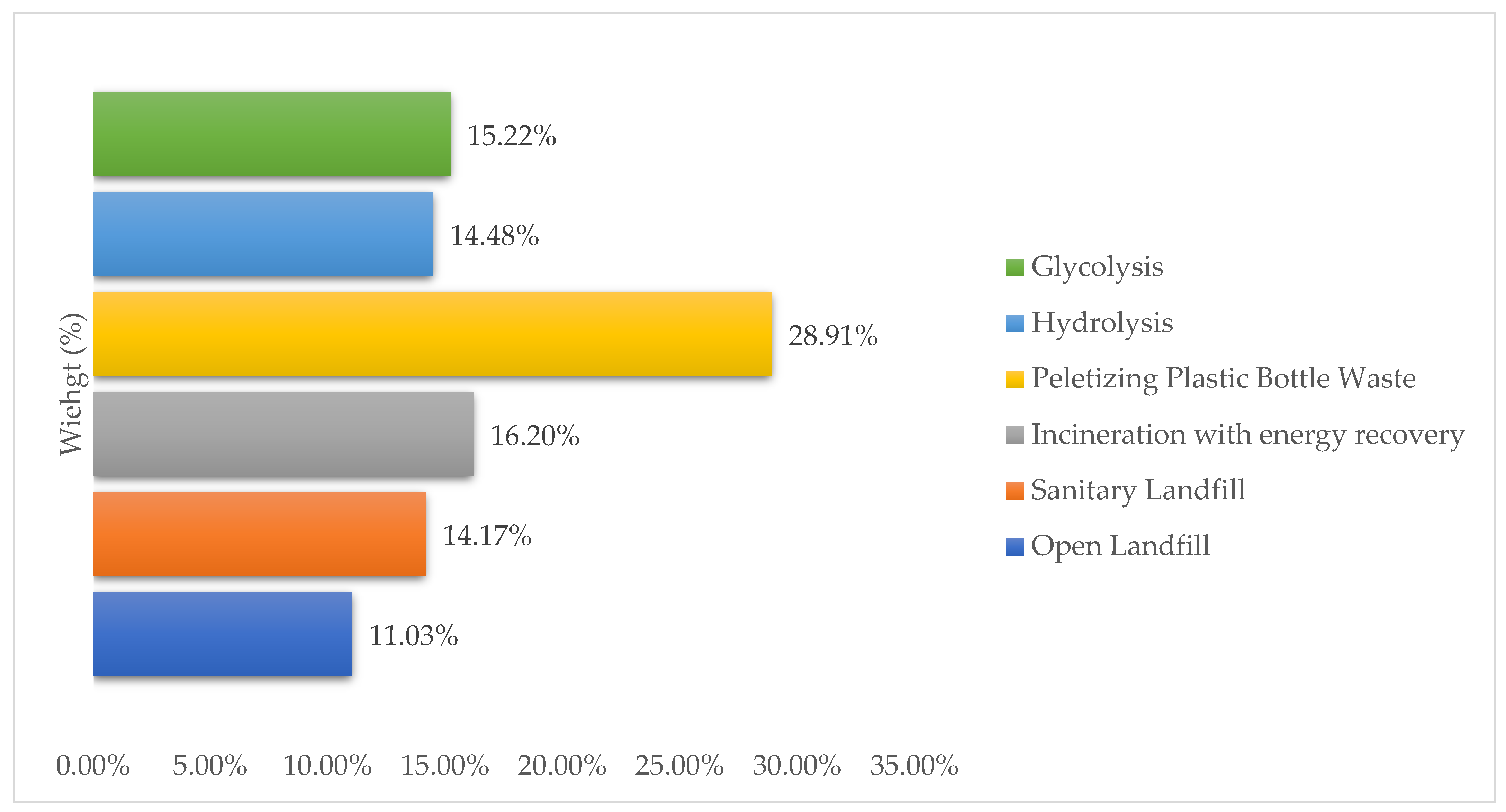

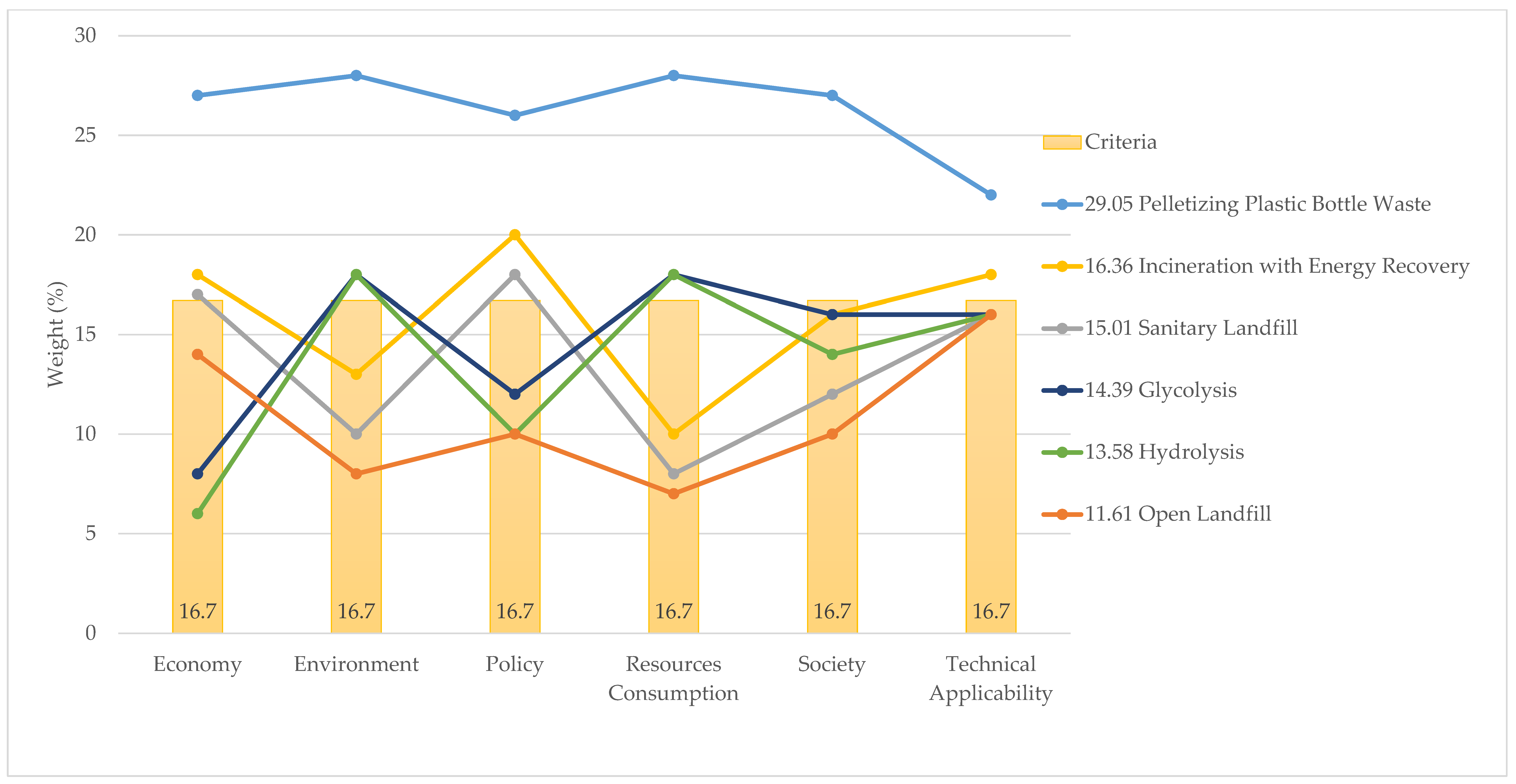
| Score | Definition |
|---|---|
| 1 | Equal importance between two criteria |
| 2 | Between equal and weak difference between criteria |
| 3 | Weak difference between criteria |
| 4 | Between weak and strong difference between criteria |
| 5 | Strong difference between criteria |
| 6 | Between strong and demonstrated difference between criteria |
| 7 | Demonstrated difference between criteria |
| 8 | Between demonstrated and absolute difference between criteria |
| 9 | Absolute difference between criteria |
| No. | Stakeholder’s Category | Description | Number |
|---|---|---|---|
| 1. | Government | Head department of waste policy and management | 3 |
| 2. | Mineral water producer and seller | Prominent producer and seller of mineral drinking water | 2 |
| 3. | Recycler industry association | Head of the association of the waste plastic recycling industry | 2 |
| 4. | Scavenger association | Head of the scavenger and waste picker association | 3 |
| 5. | Nongovernmental organization | Nongovernmental organizations focused on environmental and waste problems | 4 |
| 6. | Public opinion leader | Prominent personality actively addressing the plastic waste problem | 3 |
| 7. | Waste bank operator | Community organization operator for sorting municipal solid waste | 4 |
| 8. | Household | Households joining plastic waste utilization groups | 3 |
| Total | 24 | ||
| No. | Expert Category | Description | Number |
|---|---|---|---|
| 1. | International expert | International scholars specialized in the research on waste technology | 4 |
| 2. | Indonesian expert | Indonesian professors of integrated solid waste treatment technologies | 3 |
| Total | 7 | ||
| A1 | A2 | …… | An | |
|---|---|---|---|---|
| A1 | w1/w1 | w1/w2 | …… | w1/wn |
| A2 | w2/w1 | w2/w2 | …… | w2/wn |
| …… | …… | …… | …… | …… |
| An | wn/w1 | wn/w2 | …… | wn/wn |
| n | 1 | 2 | 3 | 4 | 5 | 6 | 7 | 8 | 9 | 10 |
|---|---|---|---|---|---|---|---|---|---|---|
| RI | 0.00 | 0.00 | 0.52 | 0.89 | 1.11 | 1.25 | 1.35 | 1.40 | 1.45 | 1.49 |
| Environment | Resource Consumption | Economy | Society | Policy | Technical Applicability | Priority Vector | |
|---|---|---|---|---|---|---|---|
| Environment | 1 | 1 | 3 | 0.5 | 3 | 3 | 0.227 |
| Resource consumption | 1 | 1 | 1 | 0.5 | 2 | 2 | 0.167 |
| Economy | 0.33 | 1 | 1 | 0.33 | 0.5 | 0.5 | 0.086 |
| Society | 2 | 2 | 3 | 1 | 3 | 2 | 0.298 |
| Policy | 0.33 | 0.5 | 2 | 0.33 | 1 | 2 | 0.119 |
| Technical applicability | 0.33 | 0.5 | 2 | 0.5 | 0.5 | 1 | 0.103 |
Publisher’s Note: MDPI stays neutral with regard to jurisdictional claims in published maps and institutional affiliations. |
© 2022 by the authors. Licensee MDPI, Basel, Switzerland. This article is an open access article distributed under the terms and conditions of the Creative Commons Attribution (CC BY) license (https://creativecommons.org/licenses/by/4.0/).
Share and Cite
Amirudin, A.; Inoue, C.; Grause, G. Analyzing Polyethylene Terephthalate Bottle Waste Technology Using an Analytic Hierarchy Process for Developing Countries: A Case Study from Indonesia. Recycling 2022, 7, 58. https://doi.org/10.3390/recycling7040058
Amirudin A, Inoue C, Grause G. Analyzing Polyethylene Terephthalate Bottle Waste Technology Using an Analytic Hierarchy Process for Developing Countries: A Case Study from Indonesia. Recycling. 2022; 7(4):58. https://doi.org/10.3390/recycling7040058
Chicago/Turabian StyleAmirudin, Akhmad, Chihiro Inoue, and Guido Grause. 2022. "Analyzing Polyethylene Terephthalate Bottle Waste Technology Using an Analytic Hierarchy Process for Developing Countries: A Case Study from Indonesia" Recycling 7, no. 4: 58. https://doi.org/10.3390/recycling7040058
APA StyleAmirudin, A., Inoue, C., & Grause, G. (2022). Analyzing Polyethylene Terephthalate Bottle Waste Technology Using an Analytic Hierarchy Process for Developing Countries: A Case Study from Indonesia. Recycling, 7(4), 58. https://doi.org/10.3390/recycling7040058







